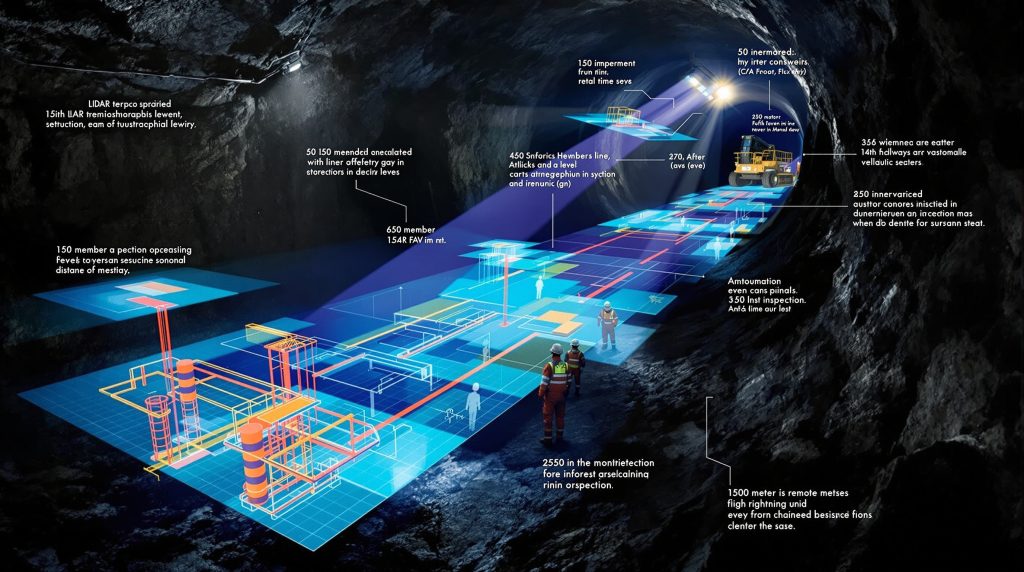Understanding Safe Re-Entry at Grosvenor Mine: A Comprehensive Analysis
Anglo American's Grosvenor mine recently marked a significant milestone with crews returning underground for the first time since an explosion halted operations at the Moranbah site more than a year ago. This carefully orchestrated re-entry process represents not just a technical achievement, but also showcases industry-leading safety protocols and technological innovation in mine recovery operations.
What Happened at the Grosvenor Mine?
The Incident That Halted Operations
The Grosvenor mine, located in Queensland's Moranbah region, experienced a serious explosion that forced the immediate suspension of all underground operations. This incident represented one of the most significant mine safety challenges in recent Australian mining history, with impacts extending beyond the immediate operational shutdown.
The explosion halted production for more than 12 months, creating ripple effects throughout the Moranbah community where the mine serves as a crucial economic pillar. Local businesses, contractors, and service providers all felt the economic impact of the extended shutdown.
Within Australia's mining safety context, the Grosvenor incident prompted renewed industry-wide focus on underground hazards, particularly around methane management and explosion prevention protocols. The extended closure period was necessary to conduct thorough investigations and implement comprehensive mine reclamation innovations before any consideration of resuming operations.
Regulatory Response and Investigation
Following the incident, Resources Safety and Health Queensland (RSHQ) led comprehensive investigations to determine root causes and required safety improvements. The regulatory response included stringent requirements that needed to be satisfied before any re-entry approval could be granted.
The investigation findings highlighted specific areas requiring attention before operations could resume, with a strong focus on atmospheric monitoring, ventilation systems, and emergency response capabilities. These requirements formed the foundation of the recovery plan developed by Anglo American.
The road to re-entry approval involved extensive collaboration between Anglo American's technical teams, RSHQ inspectors, and industry safety representatives. This multi-stakeholder approach ensured that all safety concerns were thoroughly addressed through a methodical, evidence-based process that prioritized worker safety above all else.
How Is Safe Re-Entry Being Managed?
The Phased Re-Entry Approach
The re-entry strategy at Grosvenor follows a carefully structured, multi-stage process developed in consultation with safety authorities. This methodical approach breaks down the complex recovery operation into manageable phases with clear safety objectives for each step.
Initial reconnaissance activities were conducted by specialized teams from the Queensland Mines Rescue Service, who progressed approximately 1,500 meters underground to conduct preliminary assessments. These early inspections laid the groundwork for subsequent re-entry phases by gathering critical information about underground conditions.
The phased approach includes distinct milestones: initial reconnaissance, controlled re-ventilation, infrastructure assessment, rehabilitation planning, and finally, preparation for eventual return to production. Each phase must be completed and validated before proceeding to the next, ensuring safety remains the primary consideration throughout the recovery process.
According to Anglo American's General Manager Shane McDowall, this structured approach represents "the first of many structured steps to ensure a safe, controlled and phased return" to operations at the site.
Advanced Technology Deployment
A standout feature of the Grosvenor recovery operation has been the application of cutting-edge technology to minimize human exposure to potential hazards. Central to this technological approach is the use of LiDAR torpedo systems deployed through surface boreholes.
These sophisticated remote sensing devices are equipped with high-definition cameras and advanced atmospheric sensors that collect comprehensive data about underground conditions. The technology provides detailed information about structural integrity, environmental parameters, and potential hazards without requiring human entry.
This remote assessment approach generated what McDowall described as "unprecedented visibility of the underground environment," allowing the recovery team to develop detailed plans based on accurate, current information about conditions throughout the mine.
The data collection methodology integrated multiple sensor systems to create comprehensive underground mapping that guided subsequent in-person inspection activities, ensuring teams entered with maximum situational awareness and preparation.
What Safety Protocols Are Being Implemented?
Re-Ventilation and Atmospheric Control
Re-establishing safe atmospheric conditions underground represented one of the most critical and technically challenging aspects of the recovery operation. The process began with completed re-ventilation activities in early August 2023, following rigorous planning and preparation.
The re-ventilation process required careful monitoring of gas levels, oxygen content, and other atmospheric parameters throughout the mine. This involved strategic management of airflow to gradually establish stable, breathable conditions while preventing any potential for ignition or explosive concentrations of gases.
Comprehensive atmospheric monitoring systems were installed to provide continuous real-time data from multiple locations throughout the mine. These systems establish predetermined safety thresholds that trigger alerts if conditions begin to deteriorate, providing critical early warning capability.
The ventilation infrastructure itself required thorough assessment and restoration where necessary, ensuring that airflow could be maintained reliably and adjusted as needed during the recovery operation. This infrastructure review encompassed fans, ducting, regulators, and control systems essential for maintaining safe atmospheric conditions.
Personnel Safety Measures
The approximately 50 crew members deployed underground as part of the recovery operation received specialized training focused on the unique challenges of mine re-entry. This included scenario-based exercises simulating potential hazards and emergency situations specific to a recovery environment.
Personal protective equipment requirements for re-entry teams exceed standard mining PPE, with additional respiratory protection, gas detection devices, and communication equipment. Each team member carries multiple redundant safety systems to ensure maximum protection in the dynamic post-incident environment.
Communication systems received particular attention, with enhanced underground networks ensuring teams maintain constant contact with surface control centers. These systems provide both voice communication and data transmission from personal monitoring devices carried by each team member.
Emergency response protocols were customized for the re-entry operation, with dedicated rescue teams on standby, predetermined withdrawal triggers, and clear evacuation routes established. These measures ensure rapid response capability if conditions change unexpectedly during underground activities.
Who Is Involved in the Re-Entry Process?
Coordination Between Stakeholders
The successful management of such a complex recovery operation depends on effective coordination between multiple stakeholders, each bringing specialized expertise to the process. Resources Safety and Health Queensland provides regulatory oversight and technical guidance throughout the recovery operation.
Industry Safety and Health Representatives participate in planning, risk assessment, and operational reviews, ensuring worker safety considerations remain paramount. Their involvement brings valuable industry experience and an independent perspective to safety decisions.
Anglo American's leadership team has maintained a strong safety focus throughout the recovery process, with General Manager Shane McDowall emphasizing that the re-entry at Grosvenor mine approved "reflects a strong focus on safety and the commitment of the team on site."
The Queensland Mines Rescue Service has played a crucial role, conducting initial reconnaissance and providing specialized expertise in hazardous environment operations. Their experience in mine emergency response brings invaluable practical knowledge to the recovery process.
The Re-Entry Team
The core recovery operation involves approximately 50 specialized personnel with the skills and training necessary for this challenging environment. Team composition includes ventilation specialists, structural engineers, atmospheric monitoring technicians, and experienced underground miners.
Selection for the re-entry team required demonstration of specific qualifications, experience in post-incident environments, and completion of specialized training programs developed specifically for the Grosvenor recovery. This ensured all personnel possessed the necessary skills and judgment for safe operation.
The leadership structure establishes clear decision-making authority and communication protocols, with designated team leaders responsible for specific aspects of the operation. This clear chain of command ensures coordinated action and rapid response to changing conditions.
Safety-critical decisions follow established protocols with multiple verification steps and conservative thresholds. The approach emphasizes that any team member can halt operations if safety concerns arise, reinforcing a culture where safety takes precedence over operational progress.
What Challenges Must Be Overcome?
Infrastructure Assessment Challenges
Evaluating structural integrity after prolonged closure presents significant technical challenges, as underground mining environments can deteriorate rapidly when unattended. The assessment process must identify potential structural weaknesses, water damage, or ground movement that could create hazards.
The recovery team employs a methodical approach to hazard identification, using both remote sensing data and direct inspection to create comprehensive risk mapping throughout the mine. This dual approach ensures no potential issues are overlooked during the progressive inspection process.
The methodology for clearing areas follows a strict sequence: remote assessment, limited personnel entry for detailed inspection, engineering evaluation, and finally designation of areas as either requiring rehabilitation or suitable for operational access. This sequential approach maintains safety while efficiently expanding the assessed footprint.
A key challenge involves balancing thoroughness with operational efficiency, as the assessment process must be comprehensive enough to identify all potential hazards while progressing at a pace that allows the overall recovery to proceed. This balance requires careful planning and resource allocation to maintain momentum without compromising safety standards.
Environmental Monitoring Complexities
Managing atmospheric monitoring in a recovering mine environment presents unique challenges that exceed normal operational requirements. The team employs both continuous monitoring systems at fixed locations and portable monitoring carried by personnel to provide redundant data coverage.
Potential gas accumulations require particular attention, as pockets of methane or other gases may collect in isolated areas despite general ventilation. Detection and dispersal of these accumulations involves specialized techniques and equipment to prevent any possibility of ignition.
Temperature and humidity variations can affect both equipment performance and personnel endurance, requiring additional controls to maintain safe working conditions. These environmental factors also influence the reliability of electronic systems crucial for safety monitoring.
Establishing long-term environmental stability represents the ultimate goal of the recovery process, transitioning from intensive monitoring during re-entry to sustainable systems suitable for resumed operations. This transition requires demonstration of consistent atmospheric conditions over extended periods before operational status can be considered.
What Innovations Are Driving Safer Mining Operations?
Problem-Solving and Adaptation
According to McDowall, one of the most impressive aspects of the recovery operation has been how "our crews have stepped up in amazing ways – solving problems, adapting technology in innovative ways, and rethinking how we do things underground." This culture of innovation has been essential to overcoming the unique challenges presented by the Grosvenor situation.
The recovery process has necessitated developing solutions specifically tailored to the conditions at Grosvenor, as standard approaches often proved insufficient for the complexity of the environment. These innovations include modified equipment, customized assessment protocols, and specialized decision-making frameworks.
Existing technologies have been adapted in creative ways to meet the specific challenges of the recovery operation. For example, LiDAR systems originally designed for different applications were modified to function effectively in the mine environment, demonstrating the team's technical adaptability.
Many of the innovations developed during the Grosvenor recovery have potential applications across the broader mining industry, particularly for incident response and hazardous environment operations. These transferable lessons may contribute to improved safety practices throughout the sector.
Technology Integration for Safety
Remote sensing technologies have proven invaluable for reducing human exposure to potential hazards, allowing detailed assessment of conditions before personnel entry. These technologies continue to evolve, with increasing capabilities for autonomous operation in high-risk environments.
The integration of data from multiple sources – atmospheric monitoring, structural assessment, water management, and electrical systems – creates a comprehensive risk assessment platform that provides decision-makers with complete situational awareness. This integrated approach represents a significant advancement over traditional compartmentalized monitoring.
Predictive analytics are increasingly being applied to safety management, using historical and real-time data to identify potential issues before they develop into hazards. This forward-looking approach shifts safety management from reactive to proactive by highlighting concerning trends or conditions.
Looking forward, technological developments for mine safety will likely include more autonomous inspection capabilities, enhanced sensor networks, artificial intelligence for data-driven mining operations, and improved communication systems for emergency response. These advancements will continue to reduce risk exposure while improving assessment accuracy.
What Are the Next Steps in Mine Recovery?
From Inspection to Operational Readiness
Current inspection activities will validate the findings from remote sensing operations, confirming or refining the understanding of underground conditions. This validation process is essential for developing accurate rehabilitation plans tailored to specific areas of the mine.
Before production can resume, extensive rehabilitation work will be required to restore infrastructure, reinforce ground support where necessary, and replace or repair damaged equipment. The scope of this rehabilitation will be determined by the findings of the current inspection phase.
Equipment testing and recommissioning represents another critical step in the recovery process, as systems that have remained idle for extended periods require thorough evaluation before being returned to service. This includes electrical systems, pumps, conveyor networks, and mining equipment.
While no specific timeline has been announced for return to production, industry experience suggests that the recovery process will continue for several months as the team methodically completes each phase of the recovery plan. The focus remains on thorough, safety-focused progress rather than rushing to resume operations.
Long-Term Safety Enhancements
The incident and subsequent recovery have resulted in permanent improvements to safety systems at Grosvenor mine, incorporating lessons learned throughout the process. These enhancements will establish new benchmarks for underground coal mining safety in Australia.
New safety systems being implemented include enhanced gas monitoring networks, improved ventilation control systems, and more sophisticated emergency response capabilities. These technological improvements form part of a comprehensive approach to preventing similar incidents in the future.
Training programs and operational procedures have been extensively revised based on investigation findings and recovery experiences. These changes emphasize hazard recognition, early intervention, and effective emergency response to create multiple layers of protection.
Ongoing monitoring and review processes will continue after operations resume, maintaining heightened vigilance and ensuring that safety improvements are sustained over time. This commitment to continuous evaluation and improvement represents a fundamental aspect of the safety culture being reinforced through the recovery process.
FAQ: Safe Mine Re-Entry Procedures
What makes mine re-entry particularly dangerous?
Mine re-entry operations face multiple atmospheric hazards, with potential accumulations of explosive gases, oxygen-deficient zones, or toxic gas concentrations representing the most immediate threats to personnel safety. These atmospheric risks require extensive monitoring and control measures before and during re-entry activities.
Structural integrity concerns increase significantly after prolonged closure, as ground pressure, water ingress, and lack of maintenance can compromise roof supports, roadways, and other critical infrastructure. These structural issues may create collapse hazards that weren't present during normal operations.
Water accumulation presents multiple hazards, including flooding risks, electrical safety issues, and deterioration of ground conditions. Managing water inflow and accumulated pools requires specialized pumping operations and careful electrical isolation procedures to prevent secondary hazards.
Psychological factors also affect re-entry personnel, who must maintain heightened situational awareness and readiness for emergency response while working in an environment known to have experienced a serious incident. This psychological dimension requires specific preparation and support systems.
How do regulators determine when re-entry is safe?
Regulatory approval for mine re-entry follows a structured risk assessment framework that evaluates proposed methodologies against established safety standards and site-specific hazards. This assessment examines both technical controls and operational procedures to ensure adequate risk mitigation.
Before approval, mine operators must demonstrate through comprehensive testing and monitoring that environmental conditions have stabilized sufficiently to permit safe entry. This demonstration typically includes extended monitoring periods to establish consistent atmospheric trends.
Documentation requirements include detailed re-entry plans, risk assessments, emergency response procedures, and evidence of personnel training and equipment readiness. These documents undergo thorough regulatory review before approval consideration.
Throughout the re-entry process, regulatory oversight continues with regular inspections, progress reviews, and verification activities. This ongoing involvement ensures compliance with approved procedures and provides additional technical expertise to support safe operations.
What technologies are most critical for safe re-entry?
Advanced atmospheric monitoring technologies represent the most critical technical component of safe re-entry operations. These systems combine fixed and portable sensors to provide continuous data on gas concentrations, oxygen levels, temperature, and other environmental parameters throughout the mine.
Remote inspection capabilities significantly enhance safety by reducing human exposure to potential hazards during initial assessment phases. Technologies such as camera-equipped drones, robotic crawlers, and sensor packages deployed through boreholes allow thorough evaluation of conditions without personnel entry.
Reliable communication systems form the backbone of safe re-entry operations, ensuring teams maintain constant contact with surface control centers and each other. Modern systems integrate voice communication, location tracking, and environmental data transmission to provide comprehensive situational awareness.
Data integration platforms that combine information from multiple sources into usable decision-support tools help teams identify potential hazards and make informed decisions. These systems transform raw data into actionable intelligence that supports both planning and operational activities.
How does the Grosvenor re-entry compare to other mine recovery operations?
While each mine recovery operation presents unique challenges based on specific incident characteristics and mine conditions, the Grosvenor re-entry process appears to align with industry best practices established during previous major Australian mine recovery operations. The phased approach, extensive use of technology, and multi-stakeholder involvement reflect lessons learned from past experiences.
International best practices for mine recovery operations increasingly emphasize remote assessment technology, staged re-entry protocols, and comprehensive atmospheric monitoring. The Grosvenor operation demonstrates implementation of these global standards while adapting them to site-specific conditions.
The Grosvenor site presents particular challenges related to its modern longwall mining configuration, complex ventilation network, and the nature of the original incident. These factors necessitated specific technical approaches not required in other recovery operations.
Notable innovations in the Grosvenor recovery include the sophisticated application of 3D geological modelling through boreholes and the integration of multiple data streams to create comprehensive underground mapping before personnel entry. These approaches may establish new benchmarks for future recovery operations in similar environments.
Further Exploration
Understanding mine safety and re-entry procedures involves ongoing education and awareness of evolving best practices. The Grosvenor experience highlights the mining industry's commitment to continuous improvement in safety protocols, technological innovation, and risk management strategies.
The recovery operation demonstrates how modern mining companies approach serious incidents – with methodical planning, technological sophistication, and unwavering focus on personnel safety. These principles apply not just to recovery operations but to everyday mining activities where prevention remains the primary goal.
As mining operations continue to advance technologically, the integration of remote sensing, data analytics, and autonomous systems will likely play an increasing role in both normal operations and emergency response. The innovations deployed at Grosvenor represent steps along this technological evolution toward safer mining practices.
For those interested in mining safety developments, resources such as industry publications, regulatory guidance documents, and case studies of previous recovery operations provide valuable context for understanding the complexities involved in modern mine planning and implementing industry innovation trends effectively.
Want to Stay Ahead of Major ASX Mining Discoveries?
Discover why significant mineral finds can lead to exceptional returns by exploring Discovery Alert's dedicated discoveries page, where their proprietary Discovery IQ model delivers instant notifications on ASX mineral announcements, transforming complex data into actionable investment opportunities.




